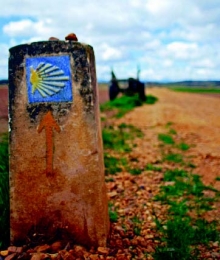The Camino de Santiago, or the Way of St James, is a series of ancient pilgrim routes across Europe that lead to the cathedral of Santiago de Compostela, in Spain’s northwestern region of Galicia.
 The opening of the cathedral’s ‘Holy Door’ on 31 December last inaugurated the jubilee year that occurs whenever the feast day of St James (25 July) falls on Sunday. Tradition claims that pilgrims walking the Camino in such a year can be forgiven for all their sins.
The opening of the cathedral’s ‘Holy Door’ on 31 December last inaugurated the jubilee year that occurs whenever the feast day of St James (25 July) falls on Sunday. Tradition claims that pilgrims walking the Camino in such a year can be forgiven for all their sins.
The Way of St James, declared as a World Heritage Site by Unesco in 1993, has existed for over a thousand years. Legend holds that Santiago/St James, who was one of Jesus’ disciples, had been sent to Spain to preach the Gospel. After his return to Judea, he was martyred and his body was carried from Palestine to the Atlantic coast of Spain by his own disciples. The apostle was buried at a secret place on the site of which is now the city of Santiago de Compostela.
Centuries later, around 813AD, a hermit named Pelayo discovered his tomb when led by a vision. The relics were authenticated by the local bishop, and Santiago was declared to be the patron saint of Spain. The discovery of the apostle’s remains brought pilgrims coming from all over Europe to reach the shrine. Indeed, during medieval times Compostela became the third major site of Christendom after Rome and Jerusalem.
Although considered in the beginning as a focal point of the Christian faith, the Camino has been – and still is – an exchange of cultures and experiences, but especially a reason for knowing oneself better.
There are also many routes to take, the most popular being the so-called Camino Frances, which begins in the Pyrenees. The itinerary offers a better infrastructure than other routes and a large range of accommodation.
“I did not walk the Camino for religious reasons but as a personal challenge,” says Alvaro, a Spanish student in Dublin. “I wanted to try a different way of travelling and to meet new people”.
Alvaro thinks that the pilgrimage was “a very positive experience that I would recommend to everybody to discover idyllic landscapes, and to test yourself against adversity.”
In 1992, a group of pilgrims passionate about the Camino founded the Irish Society of the Friends of St James. The aim of this group is not only to promote the pilgrimage to Santiago de Compostela, but also to encourage people to participate in this experience.
Robert Poynton, one of the members of this society, is an experienced walker who has already completed the French, Portuguese and English Ways and is planning to walk part of the Camino del Norte this year.
“I had retired from business and I needed time to reflect on my future. The camino offered a wonderful opportunity to do this,” he explains. “The combination of a sense of history, religious reflection and companionship – with the presence of beautiful countryside – all made the caminos memorable occasions.”
According to Poynton, statistics published by the Archdiocese of Santiago show that 1,722 Irish pilgrims recorded their arrival in 2009. Allowing for the small population of Ireland, it ranks this country in third place after Spain and Portugal.
The society does not promote any particular route, but encourages pilgrims to use some of the ancient paths starting in Ireland, such as St Patrick's Road to Croagh Patrick and St Kevin's Way in Glendalough.











